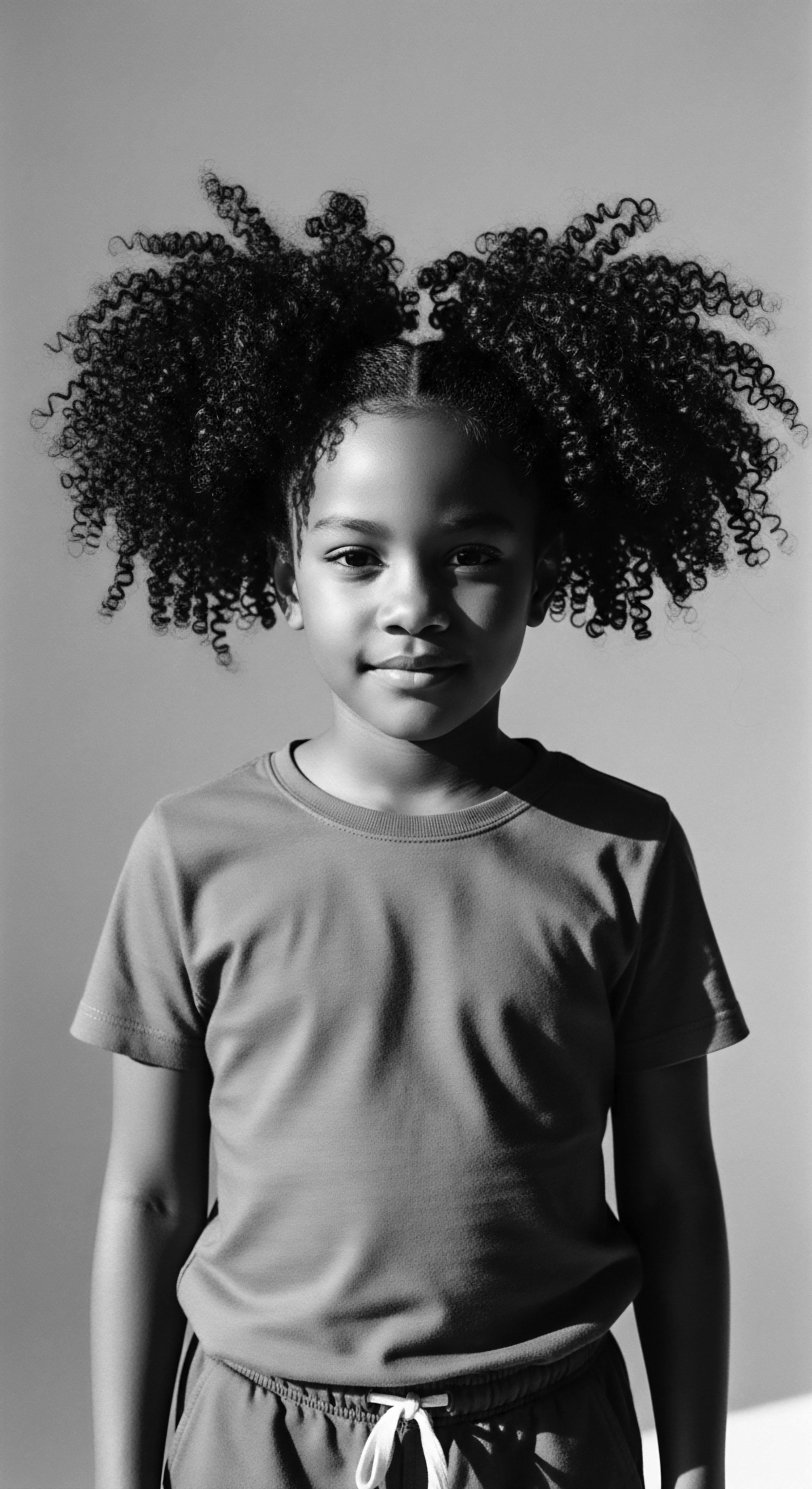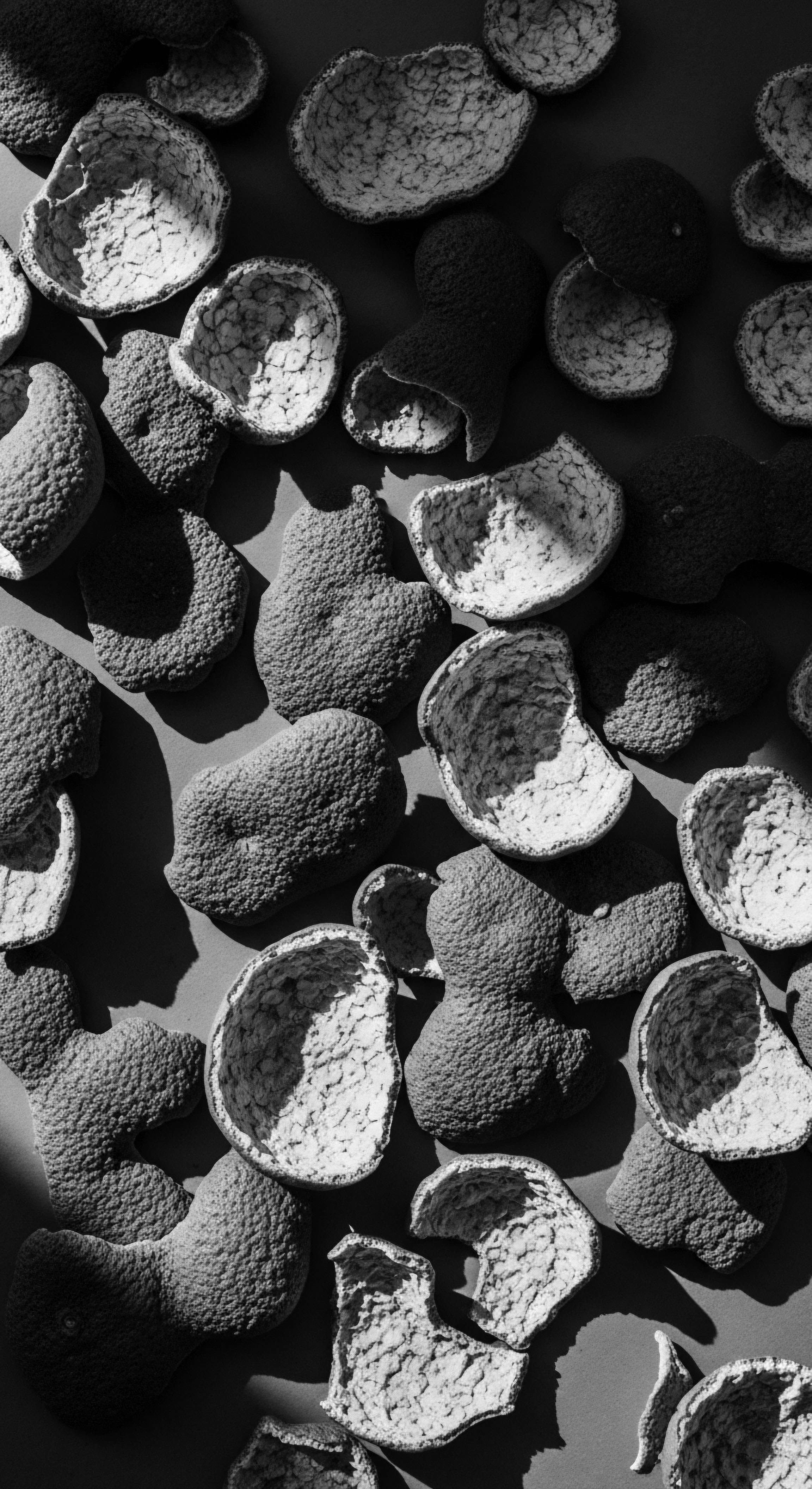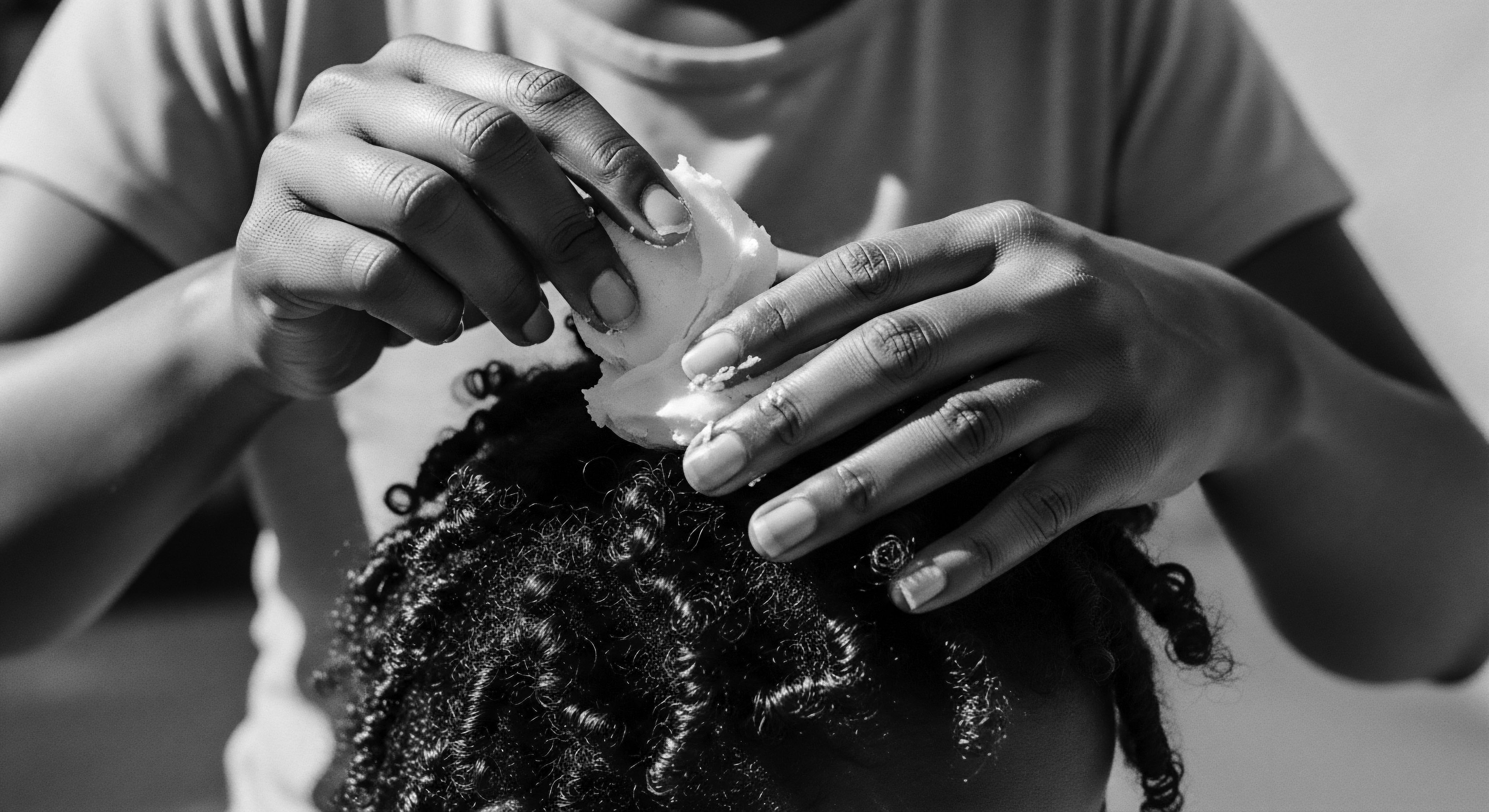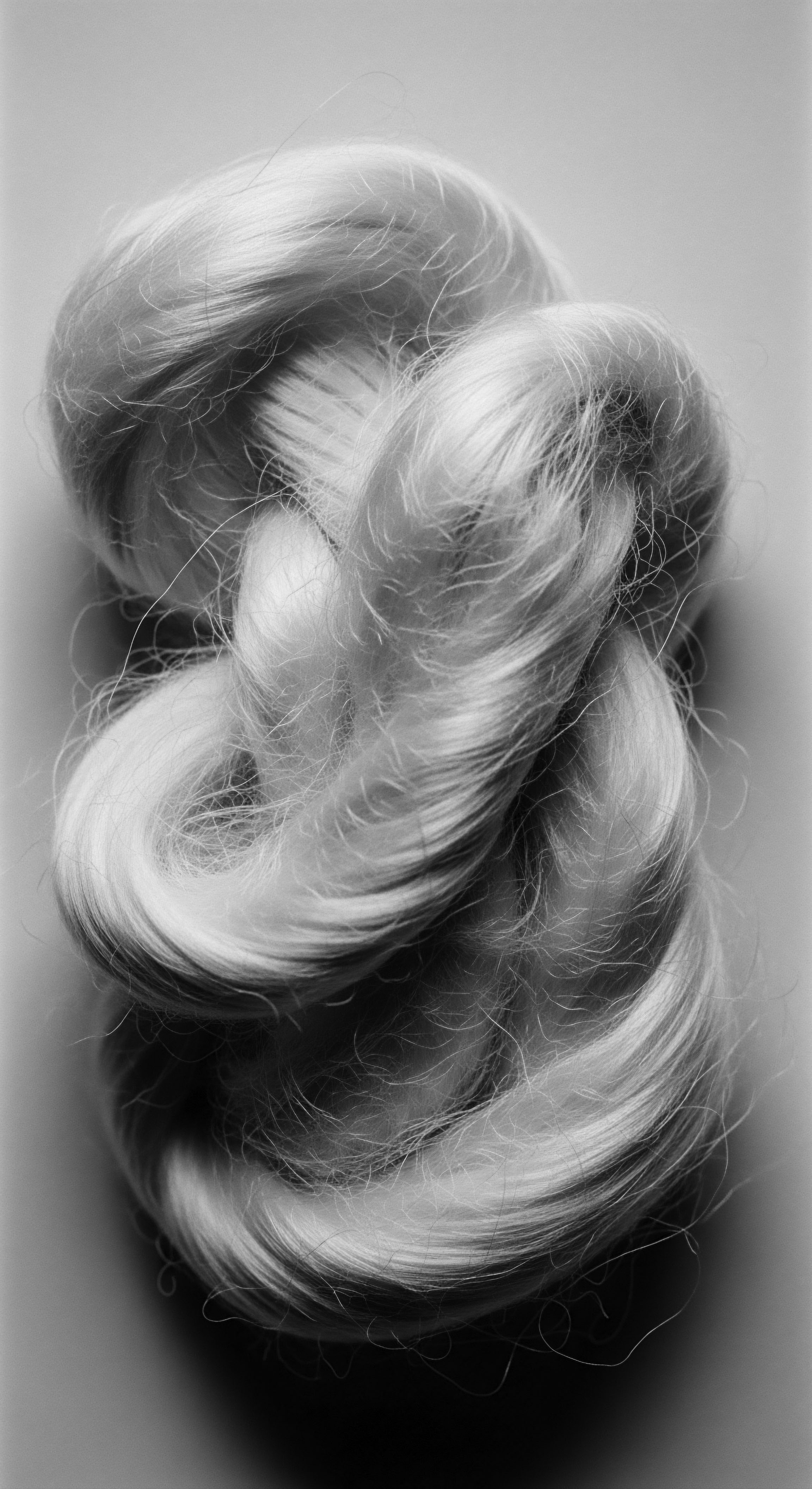
Fundamentals
The very notion of Follicle Miniaturization, at its most elemental, describes a process where a hair follicle, the tiny organ responsible for producing a hair strand, progressively shrinks. Imagine a sturdy, deep-rooted tree in a fertile forest; its branches are full, its leaves vibrant. This is akin to a healthy hair follicle, anchoring a robust strand. Now, envision that tree, over time, becoming smaller, its roots less expansive, its leaves sparse and fragile.
This transformation mirrors follicle miniaturization, leading to the production of finer, shorter, and often lighter hairs, eventually, in some instances, ceasing hair production altogether. It is a biological phenomenon, yet its reverberations extend far beyond mere physiology, particularly when we consider the rich and complex heritage of textured hair.
This diminishment of the follicle’s size and capacity is a key indicator of certain types of hair thinning and loss. It is not an abrupt cessation but a gradual transition, a whispered retreat from the vibrant fullness once known. The hairs produced by miniaturized follicles often lack the strength, elasticity, and pigment of their predecessors, appearing almost like a wispy, barely-there shadow of what once was. Understanding this basic mechanism is the first step in appreciating the deeper significance of hair health, especially for those whose hair carries the ancestral stories of textured strands.

The Whispers of Change ❉ Early Signs
Recognizing the initial whispers of follicle miniaturization can be a gentle invitation to deeper care. For individuals with textured hair, these signs might present differently than in other hair types, often masked by the inherent volume and curl pattern. A noticeable reduction in hair density, a feeling of thinner braids or twists, or even an increase in shedding of very fine, short strands can be early indicators. It is about paying close attention to the language our hair speaks, a language often rooted in generations of care and observation.
- Reduced Hair Diameter ❉ The individual hair strands become noticeably finer.
- Shortened Growth Cycle ❉ Hairs shed prematurely, before reaching their full length.
- Decreased Hair Density ❉ The overall volume of hair on the scalp appears less robust.
These subtle shifts, while seemingly small, can carry profound implications for the overall appearance and perceived health of textured hair, influencing styling choices and personal confidence.

Beyond the Visible ❉ The Follicle’s Inner World
The follicle itself is a marvel of biological design, a living wellspring from which each strand emerges. Within its depths, cells divide and differentiate, guided by intricate genetic instructions and nourished by a delicate network of blood vessels. When miniaturization begins, this delicate balance is disrupted. The dermal papilla, a cluster of cells at the base of the follicle, which plays a vital role in hair growth, shrinks.
This reduces the supply of nutrients and signals to the hair matrix cells, leading to the production of weaker, smaller hairs. This process, while microscopic, holds immense weight for those whose hair is a vibrant testament to their lineage.
Follicle miniaturization, in its essence, represents a subtle yet profound shrinking of the hair’s very source, altering the strength and vitality of each emerging strand.

Intermediate
Moving beyond the basic explanation, the Meaning of Follicle Miniaturization gains layers of complexity when viewed through the lens of textured hair heritage. It is not merely a biological regression; it carries echoes of historical practices, societal pressures, and the enduring resilience of Black and mixed-race communities. For centuries, hair has served as a powerful symbol within African cultures, denoting identity, social standing, age, marital status, and even spiritual beliefs. The health and presentation of hair were, and remain, deeply intertwined with one’s sense of self and connection to community.
Consider the intricate braiding traditions of West Africa, where hairstyles could carry messages or signify tribal affiliation. The ability to sculpt and mold textured hair into complex forms was a unique feature, amplified by its inherent spirality. In such contexts, any process that compromises the hair’s ability to be styled or to retain its fullness directly impacts these cultural expressions. Follicle miniaturization, therefore, is not just a clinical observation; it is a disruption to a living, breathing heritage.

Ancestral Wisdom and Modern Understanding ❉ A Dialogue
For generations, ancestral wisdom guided the care of textured hair, often employing natural ingredients and practices aimed at preserving the hair’s strength and vitality. Shea butter, various plant oils, and even specific clays were utilized for moisturizing, protecting, and nourishing the hair. These practices, passed down through families, inherently sought to maintain the very conditions that prevent miniaturization, even if the scientific terminology was absent. The traditional emphasis on scalp health, gentle handling, and protective styling can be seen as an intuitive understanding of follicular well-being.
The historical context of hair care for Black and mixed-race individuals in the diaspora further shapes our interpretation of follicle miniaturization. During periods of enslavement and beyond, Eurocentric beauty standards often devalued natural textured hair, associating it with notions of being “uncivilized” or “nappy.” This led to widespread adoption of hair straightening methods, including hot combs and chemical relaxers. While offering a semblance of conformity, these practices often inflicted damage, leading to conditions like traction alopecia.
The journey of textured hair reveals that follicle miniaturization is not merely a biological shift, but a story interwoven with cultural identity, historical pressures, and enduring traditions of care.
Traction Alopecia, a condition resulting from prolonged or repeated tension on hair follicles, commonly associated with tight hairstyles such as braids, cornrows, and weaves, frequently involves follicular miniaturization in its progression. A study on African American girls aged 5.4 to 14.3 years found signs of traction alopecia in 18% of participants, underscoring the early impact of certain styling practices. This specific instance highlights how external, culturally influenced practices can directly contribute to the internal biological process of miniaturization. The ancestral practices, conversely, often centered on minimizing tension and maximizing nourishment, acting as a bulwark against such follicular distress.

The Spectrum of Impact ❉ Beyond Genetics
While genetic predispositions play a role in some forms of hair loss, the historical and social realities for textured hair mean that environmental and cultural factors often contribute significantly to miniaturization. The very act of caring for and styling textured hair, especially under societal pressures, can become a source of stress for the follicles. This understanding allows for a more holistic and empathetic approach to addressing hair thinning in these communities, one that honors their past while seeking solutions for their present and future.
| Traditional Practice Scalp Oiling (e.g. Shea Butter, Coconut Oil) |
| Connection to Follicle Health Nourishes the scalp, reduces dryness, and provides a healthy environment for follicles. This promotes circulation and nutrient delivery, which are vital for preventing miniaturization. |
| Traditional Practice Protective Styles (e.g. Braids, Twists, Locs, when not too tight) |
| Connection to Follicle Health Minimizes manipulation and external stress on hair strands and follicles, allowing for length retention and reducing breakage that could otherwise signal follicular distress. |
| Traditional Practice Herbal Rinses and Treatments (e.g. Chebe powder, Yucca root) |
| Connection to Follicle Health Offers anti-inflammatory and strengthening properties, supporting scalp integrity and potentially reinforcing the hair shaft, thus maintaining follicle vitality. |
| Traditional Practice These practices, steeped in ancestral knowledge, intuitively supported follicular resilience long before scientific terms like 'miniaturization' were conceived. |
The interplay between genetic predispositions, environmental factors, and historical hair care practices paints a complex picture of follicle miniaturization within textured hair communities. It compels us to look beyond a purely biological definition and consider the lived experiences that shape hair health.

Academic
The academic understanding of Follicle Miniaturization transcends a simple biological definition, delving into its profound biological mechanisms, its varied clinical manifestations, and its intricate interplay with the unique characteristics and heritage of textured hair. At its core, follicle miniaturization represents a progressive diminution in the size and depth of the hair follicle, resulting in the production of increasingly thinner, shorter, and less pigmented hair shafts. This transformation, a biological regression from terminal (thick, pigmented) hair to vellus (fine, non-pigmented) hair, is a hallmark of various alopecias, with its most recognized association being androgenetic alopecia (AGA). However, for individuals of African descent and those with mixed heritage, the phenomenon carries additional layers of clinical and historical significance, often intersecting with other forms of hair loss and societal pressures.
From a biological standpoint, the primary mechanism underpinning follicle miniaturization involves a complex cascade of hormonal, genetic, and inflammatory signals. In androgenetic alopecia, dihydrotestosterone (DHT), a potent androgen, plays a central role by binding to receptors within genetically susceptible hair follicles, particularly those on the scalp. This binding initiates a series of events that shorten the anagen (growth) phase of the hair cycle and prolong the telogen (resting) phase, leading to the gradual shrinking of the follicle itself.
The miniaturized follicles, in turn, produce hair shafts with reduced diameter, length, and pigmentation, eventually becoming imperceptible vellus hairs. The integrity of the dermal papilla, the signaling center at the base of the follicle, is critically compromised during this process, impairing its ability to sustain robust hair growth.
For textured hair, particularly in individuals of African descent, the understanding of follicle miniaturization must extend beyond the conventional models predominantly derived from studies on Caucasian hair. The unique morphology of African hair follicles, characterized by their elliptical shape and retrocurvature at the bulb, along with an S-shaped hair shaft, may influence their susceptibility to various forms of stress and contribute to distinct patterns of miniaturization. This anatomical specificity implies that external forces, such as chronic tension or chemical alterations, could interact with inherent follicular characteristics in ways that exacerbate miniaturization.

The Intersecting Realities ❉ Traction Alopecia and Follicle Miniaturization
A particularly salient area of intersection for textured hair is the relationship between follicle miniaturization and Traction Alopecia (TA). While distinct conditions, TA, caused by repetitive pulling on hair follicles, often leads to inflammation and, crucially, follicular miniaturization in its earlier, non-scarring stages. Research by Miteva and Tosti (2012) identified miniaturized follicles (diameter <0.03 mm) in scalp biopsies of African-American women with traction alopecia, a finding that persisted even into late-stage TA.
This observation highlights a critical diagnostic challenge, as early TA with miniaturization can be misdiagnosed as androgenetic alopecia if scarring changes are not yet evident. The cultural practices of tight braiding, weaving, and cornrowing, deeply embedded in the styling traditions of Black and mixed-race communities, while culturally significant, have historically presented a risk factor for TA.
This clinical reality underscores a broader academic concern ❉ the disproportionate impact of certain hair care practices, often adopted due to societal pressures to conform to Eurocentric beauty standards, on the follicular health of Black women. The historical prevalence of chemical relaxers, for instance, which chemically alter the hair’s natural curl pattern, has been linked to various scalp conditions and hair fragility. While not directly causing miniaturization in the same manner as DHT, chronic inflammation or damage from such practices could potentially create an environment conducive to follicular distress and subsequent miniaturization over time, particularly in conjunction with genetic predispositions.
The historical trajectory of textured hair care, marked by both ancestral wisdom and external pressures, offers a unique lens through which to comprehend the profound impact of follicle miniaturization.
Moreover, the epidemiological data reveals important disparities. While androgenetic alopecia is highly prevalent across all populations, studies indicate variations in incidence and patterns across racial groups. For instance, Caucasian males exhibit the highest incidence and severity of AGA, followed by African Americans and Asians. However, the presentation of hair loss in African American men, for example, may show preservation of the frontal hairline, a pattern less common in Caucasian men.
This points to the need for more racially diverse clinical trials and genetic studies to fully comprehend the genetic architecture of AGA and miniaturization within African populations. A study examining a dataset of 2,136 men from Ghana, Nigeria, Senegal, and South Africa found that polygenic scores for baldness derived from European GWAS performed notably worse in predicting baldness in African populations, indicating a need for more specific research within these communities.
The Delineation of follicle miniaturization, therefore, is not solely a microscopic exercise but an anthropological one, recognizing that biological processes are deeply intertwined with cultural practices, historical trajectories, and social determinants of health. It calls for a culturally competent approach to diagnosis and management, one that acknowledges the unique heritage of textured hair and the systemic factors that have shaped its health outcomes.
The Interpretation of miniaturization within textured hair requires a nuanced understanding of its complex etiology. It is not always a straightforward genetic predisposition. Often, it is a consequence of sustained physical stress, chemical damage, or inflammatory responses at the follicular level, which can be exacerbated by the demands of certain styling practices.
The ‘fringe sign’ in traction alopecia, characterized by the retention of thinner or miniaturized hairs along the frontal hairline, is a distinct clinical manifestation that directly correlates with the presence of vellus hairs seen microscopically. This specific sign serves as a powerful indicator of mechanical stress leading to follicular compromise.
- Genetic Predisposition ❉ While research on AGA has historically focused on European populations, emerging studies are beginning to explore the genetic underpinnings of hair loss in African men, suggesting distinct genetic architectures.
- Mechanical Stress ❉ Chronic tension from tight hairstyles, such as braids or weaves, can induce inflammation and physical damage to the follicle, leading to miniaturization and ultimately scarring.
- Chemical Trauma ❉ The historical and ongoing use of harsh chemical relaxers can compromise scalp health and hair integrity, potentially contributing to follicular distress and subsequent miniaturization.
- Inflammatory Responses ❉ Various scalp conditions, some of which may be triggered or worsened by certain hair care practices, can lead to perifollicular inflammation, impacting the follicle’s ability to produce healthy hair.
The ongoing research into the genetic basis of hair loss in African populations, alongside a deeper appreciation for the historical and cultural context of textured hair care, offers a path toward more precise diagnostics and culturally sensitive interventions for follicle miniaturization. It calls for a collaborative effort between dermatologists, geneticists, and cultural historians to truly grasp the full Significance of this phenomenon within the rich tapestry of textured hair heritage.

Reflection on the Heritage of Follicle Miniaturization
As we close this exploration of Follicle Miniaturization, a profound meditation on its enduring heritage and evolving significance within the context of textured hair and its communities unfurls. The journey from elemental biology to the intricate narratives of identity and ancestral wisdom reveals that hair, in its very structure and susceptibility, carries the echoes of history. The miniaturization of a follicle, though a microscopic event, becomes a poignant symbol of the pressures and resilience that Black and mixed-race hair has navigated through centuries.
From the communal rituals of ancient African civilizations, where hair was meticulously cared for and styled as a visual lexicon of status, age, and spiritual connection, to the contemporary landscape shaped by diaspora and evolving beauty standards, the strand has held its soulful meaning. The understanding of Follicle Miniaturization, therefore, is not merely a scientific pursuit; it is an act of honoring the past, acknowledging the struggles, and celebrating the triumphs of textured hair.
The whispers of ancestral knowledge, often expressed through the intuitive application of natural oils and protective styling, were, in their essence, early forms of follicular care. They were a testament to a deep, embodied wisdom that sought to maintain the vitality of each strand, a wisdom that now finds validation in modern scientific insights. The recognition of conditions like traction alopecia, and its intimate connection to miniaturization, compels us to consider the profound impact of societal pressures on biological well-being. The very act of straightening hair, often a means of survival or assimilation, sometimes inadvertently contributed to the follicular distress we now comprehend.
Yet, within this narrative of challenge, there is also immense strength. The natural hair movement, a powerful reclamation of ancestral beauty and self-acceptance, represents a collective act of defiance against historical erasure. It is a vibrant declaration that textured hair, in all its coiled glory, is inherently beautiful and worthy of profound care.
Understanding Follicle Miniaturization within this heritage allows us to approach hair health not as a deficit to be corrected, but as a legacy to be nurtured. It invites us to listen more closely to the stories held within each strand, to connect scientific understanding with ancestral reverence, and to forge a future where every textured crown can flourish unbound.

References
- Byrd, A. D. & Tharps, L. D. (2001). Hair Story ❉ Untangling the Roots of Black Hair in America. St. Martin’s Press.
- Johnson, T. A. & Bankhead, T. (2014). Hair It Is ❉ Examining the Experiences of Black Women with Natural Hair. Open Journal of Social Sciences, 2(1), 86-100.
- Khumalo, N. P. et al. (2008). The presence of short vellus-like hairs in early traction alopecia may lend credence to a follicular miniaturization theory. Clinical and Experimental Dermatology .
- Miteva, M. & Tosti, A. (2012). Miniaturized follicles in scalp biopsies of African-American women with traction alopecia and its persistence to late-stage traction alopecia. Journal of the American Academy of Dermatology .
- O’Brien-Richardson, P. (2024). Hair and Health Among African American Women ❉ Historical and Sociocultural Considerations for Physical Activity and Mental Health. Women’s Health Issues .
- Patton, T. D. (2006). Braids, Locks, Tresses, and Roots ❉ The Politics of Black Women’s Hair. New York University Press.
- Rodney, E. (2017). Traction alopecia ❉ A neglected entity in 2017. Indian Dermatology Online Journal, 8(5), 374-378.
- Wise, L. A. et al. (2014). Hair relaxer use and risk of uterine leiomyomata in African American women. American Journal of Epidemiology, 180(5), 509-519.
- Zhu, S. et al. (1990). Hair casts and traction-inducing hairstyles. Journal of the American Academy of Dermatology, 22(5), 788-791.
